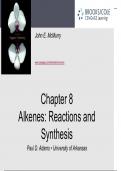Jasmynely
On this page, you find all documents, package deals, and flashcards offered by seller jasmynely.
- 23
- 0
- 4
Community
- Followers
- Following
27 items

Organohalides
Reactions involving organohalides are less frequently encountered than other organic compounds, but reactions such as nucleophilic substitutions/eliminations that they undergo will be encountered. Alkyl halide chemistry is model for mechanistically similar but more complex reactions.
- Package deal
- Presentation
- • 23 pages •
Reactions involving organohalides are less frequently encountered than other organic compounds, but reactions such as nucleophilic substitutions/eliminations that they undergo will be encountered. Alkyl halide chemistry is model for mechanistically similar but more complex reactions.

Reactions of Alkyl Halides: Nucleophilic Substitutions and Eliminations
Nucleophilic substitution, base induced elimination are among most widely occurring and versatile reaction types in organic chemistry Reactions will be examined closely to see: - How they occur - What their characteristics are - How they can be used
- Package deal
- Presentation
- • 48 pages •
Nucleophilic substitution, base induced elimination are among most widely occurring and versatile reaction types in organic chemistry Reactions will be examined closely to see: - How they occur - What their characteristics are - How they can be used

Organic Compounds: Alkanes and Their Stereochemistry
Alkanes are unreactive, but provide a useful vehicle to introduce important ideas about organic compounds. Alkanes will be used to discuss basic approaches to naming organic compounds. We will take an initial look at 3-D aspects of molecules.
- Package deal
- Presentation
- • 33 pages •
Alkanes are unreactive, but provide a useful vehicle to introduce important ideas about organic compounds. Alkanes will be used to discuss basic approaches to naming organic compounds. We will take an initial look at 3-D aspects of molecules.

Alkenes: Reactions and Synthesis
To begin a systematic description of major functional groups. Begin to focus on general principles and patterns of reactivity that tie organic chemistry.
- Package deal
- Presentation
- • 43 pages •
To begin a systematic description of major functional groups. Begin to focus on general principles and patterns of reactivity that tie organic chemistry.

Structure and Bonding
Organic chemistry – chemistry of carbon compounds. Atom: charged nucleus containing positively charged protons and netrually charged neutrons surrounded by negatively charged electrons. Electronic structure of an atom described by wave equation. Electrons occupy orbitals around the nucleus. Different orbitals have different energy levels and different shapes. s orbitals are spherical, p orbitals are dumbbell-shaped. Covalent bonds - electron pair is shared between atoms. Va...
- Package deal
- Presentation
- • 43 pages •
Organic chemistry – chemistry of carbon compounds. Atom: charged nucleus containing positively charged protons and netrually charged neutrons surrounded by negatively charged electrons. Electronic structure of an atom described by wave equation. Electrons occupy orbitals around the nucleus. Different orbitals have different energy levels and different shapes. s orbitals are spherical, p orbitals are dumbbell-shaped. Covalent bonds - electron pair is shared between atoms. Va...

Cycloalkanes and their Stereochemistry
Because cyclic molecules are commonly encountered in all classes of biomolecules: - Proteins - Lipids - Carbohydrates - Nucleic acids It is important to understand the nature of these molecules as you will encounter them in the next phases of your academic training
- Package deal
- Presentation
- • 33 pages •
Because cyclic molecules are commonly encountered in all classes of biomolecules: - Proteins - Lipids - Carbohydrates - Nucleic acids It is important to understand the nature of these molecules as you will encounter them in the next phases of your academic training

Chapter 1-3 OChem
Chapter 1 goes over structure and bonding, Chapter 2 goes over polar covalent bonds of acids and bases, and Chapter 3 introduces Alkanes.
- Presentation
- • 43 pages •
Chapter 1 goes over structure and bonding, Chapter 2 goes over polar covalent bonds of acids and bases, and Chapter 3 introduces Alkanes.
